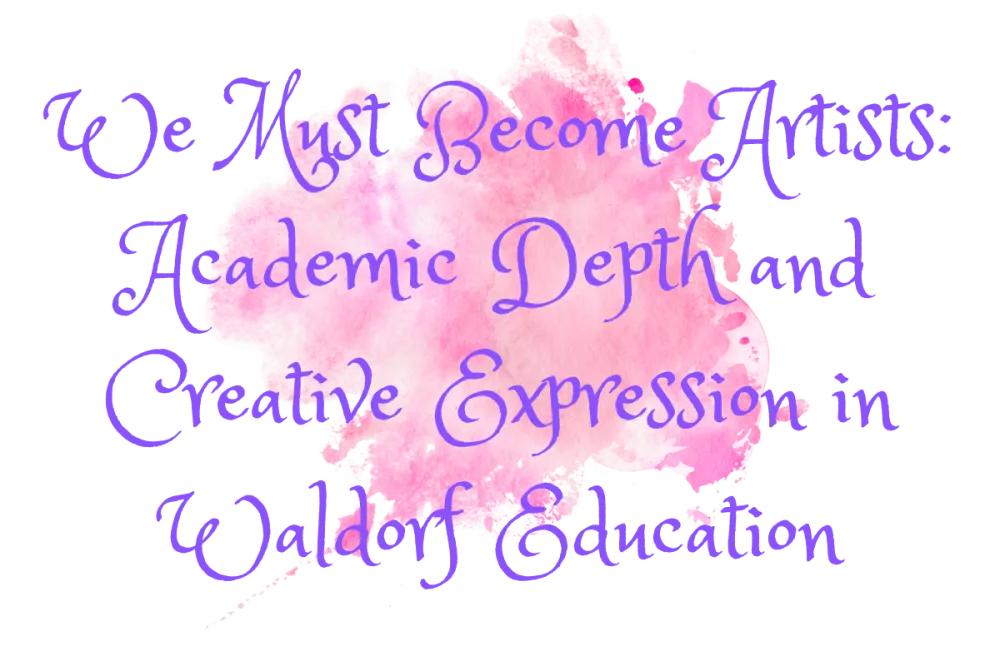« Back
We Must Become Artists: Academic Depth and Creative Expression in Waldorf Education
February 1st, 2025

As parents, we are not just raising children—we are nurturing the artists, dreamers, and innovators of tomorrow. Every moment spent encouraging their creativity is a step toward a future filled with wonder and possibility.
In Waldorf education, academic rigor and creative expression are not separate disciplines but are woven together to create a rich, immersive learning experience. By integrating subjects such as mathematics, science, and literature with the arts, music, crafts, and storytelling, Waldorf education fosters both deep comprehension and creativity in students. This holistic approach ensures that children engage with their studies in meaningful and lasting ways, making learning both joyful and profound.
_(1).jpeg?v=1738548505758)
Integrating Academics with the Arts
The Waldorf curriculum is designed to bring academic subjects to life through artistic expression. Rather than simply memorizing facts, students illustrate concepts through drawing, painting, and sculpting. For example, mathematical principles might be explored through form drawing, geometric patterns, or rhythm exercises in movement. Science lessons often incorporate observational drawing and watercolor painting to deepen understanding and appreciation of the natural world.
 The Role of Music in Learning
The Role of Music in Learning
Music is a fundamental part of the Waldorf classroom, enhancing cognitive development and emotional well-being. From the early years, students learn to play the pentatonic flute, progressing to string instruments and choral singing as they grow. These musical experiences support memory retention, pattern recognition, and social harmony, reinforcing academic subjects such as history and language arts through songs and musical storytelling.
Handwork and Crafting as Educational Tools
Handwork and crafts are essential elements of the curriculum, fostering patience, perseverance, and fine motor skills. Knitting, weaving, and woodworking teach mathematical patterns, spatial awareness, and problem-solving in a tangible, hands-on manner. These activities not only provide practical life skills but also enhance a child's ability to focus, process information, and develop resilience through perseverance.

Storytelling as a Path to Understanding
In Waldorf education, storytelling is a powerful tool for deep learning. Rather than relying on textbooks, teachers bring history, science, and literature to life through vivid narratives. This oral tradition captivates children’s imaginations and allows them to internalize knowledge in a meaningful way. By retelling and illustrating these stories, students develop comprehension, linguistic skills, and personal connection to the material.

Fostering a Love of Learning
Through this integration of academics and creativity, Waldorf students develop a profound love for learning. They approach problem-solving with innovation, express ideas with confidence, and engage deeply with their subjects. This balanced education nurtures intellectual curiosity and artistic spirit, preparing children to be well-rounded, thoughtful individuals who see learning as a lifelong adventure.
 For parents seeking an educational path that honors both academic depth and creative expression, Waldorf education offers a time-tested approach that cultivates intellectual, artistic, and emotional growth in every child.
For parents seeking an educational path that honors both academic depth and creative expression, Waldorf education offers a time-tested approach that cultivates intellectual, artistic, and emotional growth in every child.
A SPECIAL GIFT FOR YOU
Join our community of parents who are reimagining childhood—one meaningful moment at a time. Subscribe to our newsletter and receive your free copy of Adventures in Parenting. Inside, you’ll discover ways to cultivate inner healing, celebrate your child’s unique journey, and create a home environment that fosters both imagination and balance.
Together, let’s transform the everyday into something extraordinary. Enter your email on this page and begin this enriching adventure today!











